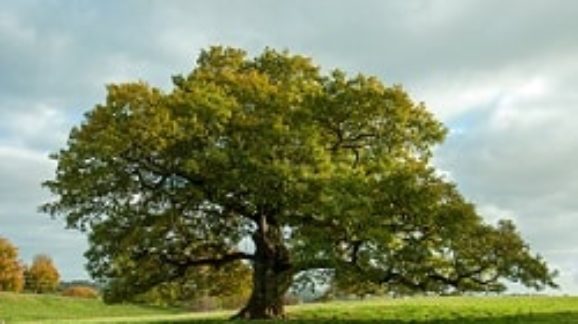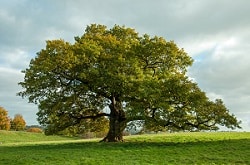Is Global Warming Killing America’s Oldest Oak Tree?

 “The oldest white oak tree in the country is dying—and no one knows why,” proclaims the title of an article in today’s Washington Post. Yet the author, Amy Ellis Nutt, thinks she knows. She believes global warming is killing “Holy Oak,” a tree already old in 1717 when farmers built a church beside it in Basking Ridge, New Jersey:
“The oldest white oak tree in the country is dying—and no one knows why,” proclaims the title of an article in today’s Washington Post. Yet the author, Amy Ellis Nutt, thinks she knows. She believes global warming is killing “Holy Oak,” a tree already old in 1717 when farmers built a church beside it in Basking Ridge, New Jersey:
It was struck more than once by lightning. It was blasted by Hurricanes Diane, Donna and Dora, then Floyd, Irene and Sandy. Through tornadoes and derechos, blizzards and floods, it buckled and bent. It swayed and swooned. But it never succumbed.
The tree’s sudden failure to thrive is a mystery. Pastor Jones thinks the reason could simply be old age. White oaks usually live between 200 and 300 years. The Basking Ridge oak has surpassed that by several centuries.
No one really knows how or why trees die. Scientists know how they grow, and they know how to reconstruct their past. But they don’t know how to predict their future—except to say that the warmer the planet becomes, the more trees will die.
Here’s a more plausible explanation: Holy Oak is in a “spiral of decline” because it has already outlived most other old oaks by two to three centuries.
Nutt’s scientific authority is U.S. Geological Survey ecologist Craig Allen, who told her: “They [i.e. trees] know there are ups and downs in water and sun, and they know how to ride them out, except that it’s become vastly harder in the age of global warming.”
How so? Nutt doesn’t say. The soil isn’t drying out, because Basking Ridge gets plenty of rain. When there was a dry spell in the 1970s, Nutt reports, local firefighters watered the tree, and from then on the town’s policy has been that if drought returns, residents “can’t water their lawns, they can’t fill their swimming pools” to ensure “there will always be water” for the tree.
Over at CO2Science.Org, Craig Idso reviews 135 studies on how trees respond to rising atmospheric carbon dioxide (CO2) concentrations. The peer-reviewed scientific literature is pretty darn unequivocal. Elevated CO2 concentrations boost trees’ water-use efficiency, increase forest primary productivity, stimulate tree photosynthetic activity, increase forest density, increase tree biomass production, extend species range, expand forest areas, increase tree height and trunk diameter, help saplings photosynthesize in poor light conditions, increase seed mass and seedling growth rates, and stimulate forest ecosystem productivity.
Holy Oak is a member of the white oak (Quecus alba) species. Elsewhere on the site, Idso reviews a study on “protracted growth increases in old trees in the eastern United States”—white oaks being one of the species investigated. Growth was measured in terms of basal area increment (BAI). The researchers, scientists at Pennsylvania State University’s School of Forest Resources, found that “even the oldest trees of several species had slow but increasing BAI values, which continued throughout the life of most trees.” That is “remarkable” given the assumption that trees stop growing after middle age. The researchers also found that “over the last 50-100 years, younger trees within a species grew faster than did the older trees when they were of the same respective age.” So species like the white oak seem to fare better today than their ancestors did.
According to the researchers, “it seems reasonable to assume” that the greater growth rates of younger long-lived trees today compared to their counterparts in former times “may be due to a stimulatory effect of anthropogenic global change defined in the broadest sense,” including “increased CO2 levels, warming temperatures, increased precipitation, and changes in precipitation chemistry.”
So it’s not just more CO2 but also warming itself that might be good for trees? Idso reviews 82 studies on that topic. Study after study shows that, if well-watered, trees typically do better in temperatures above those found in their native ranges. In addition, some studies find that elevated CO2 not only protects plants from heat stress but also raises the optimum temperature for plant growth.
Back in April, NASA released a study by 32 authors from 24 institutions in eight countries using satellite data to measure the amount of leaf cover over the planet’s vegetated areas. The researchers found that over the past 35 years, there has been an increase in leaf cover “equivalent in area to two times the continental United States.” Spectacular! You probably never heard boo about it. If instead leaf cover had shrunk by the equivalent of just 10 percent of U.S. land area, the usual suspects would be proclaiming the End of Days.
The NASA researchers estimate that 70 percent of the increase in leaf cover is due to the CO2 fertilization effect and 8 percent to global warming, with nitrogen deposition and land use changes accounting for another 9 percent and 4 percent, respectively.
Correlation is not causation. Is anthropogenic global warming (AGW) killing an otherwise robust ancient oak—or is AGW a factor that has helped the tree live so long? Or does AGW have nothing to do with the tree’s fate? The Post article offers no data or analysis to even begin sorting it out. But its bias is clear.